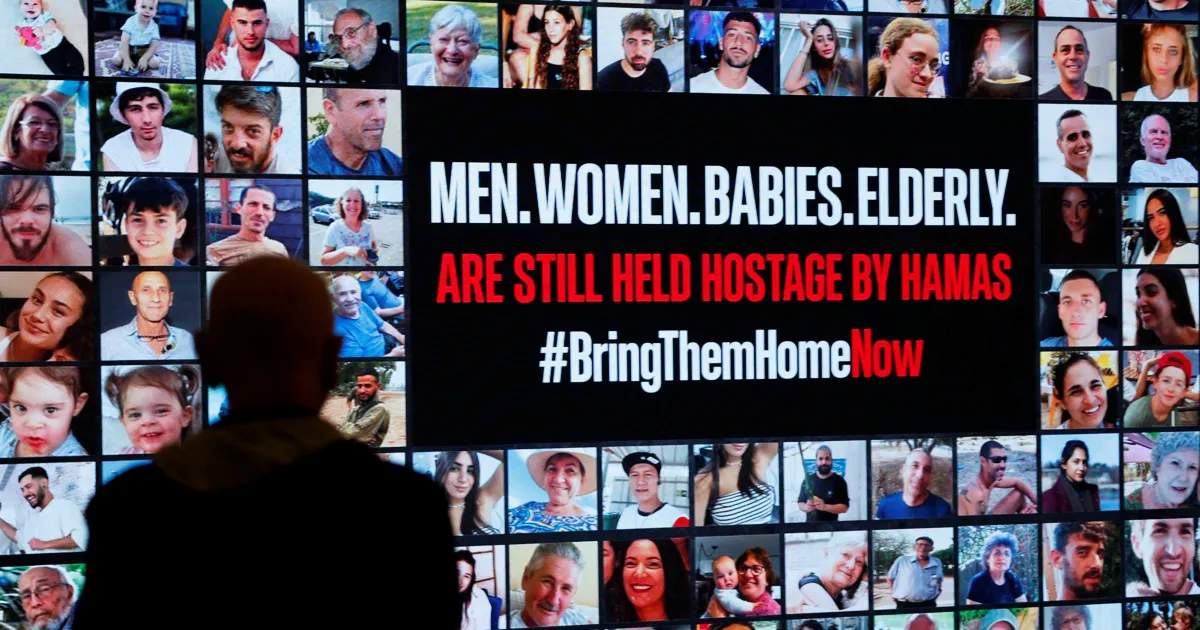Draft Israel-Hamas deal envisages release of all hostages

The draft ceasefire agreement between Israel and Hamas envisages the release of all hostages held in the Gaza Strip, according to the text of the document, published by Qatari newspaper Al Araby Al Jadeed.
"The agreement aims to release all Israeli hostages from the Gaza Strip, be they civilians or the military <...> in exchange for the release of Palestinian prisoners from Israeli jails and the resumption of a lasting truce that envisages a total cessation of hostilities and withdrawal of Israeli forces from the Gaza Strip, as well as its reconstruction," the draft says.
During phase one of the agreement, Hamas undertakes releasing 33 Israeli hostages, including women (both civilians and servicewomen), children and teenagers below 19 years of age, people aged 50 or older as well as ill and injured civilians in exchange for the release of a a large number of Palestinians kept in Israeli prisons and detention centers.
According to the swap formula, the Israeli authorities are to release 30 Palestinians aged 50 or older and inmates with medical conditions for every civilian hostage released by Hamas. In exchange for every Israeli servicewoman, Hamas expects the release of 50 Palestinian prisoners, including 30 sentenced to life imprisonment.
Phase two
No later than 16 days after the start of phase one, the sides will start indirect talks about phase two of the agreement, which envisages the release of remaining Israeli male hostages, including servicemen, on the condition that the consultations will be completed before the fifth week of the first stage.
Withdrawal of Israeli troops from Gaza
The document envisages the withdrawal of Israeli forces from the Gaza Strip and the lifting of Israel’s siege of the Palestinian enclave.
On the third day of the agreement, Israeli troops are to withdraw completely from al-Rashid Street in the east to Salah al-Din Street, and dismantle military sites and installations in this area to enable the return of displaced persons and unimpeded delivery of humanitarian aid.
On the 22nd day of the agreement, Israeli forces are to be pulled back from central areas of Gaza east of Salah al-Din Street to a zone along the border. The draft specifies that during phase one of the agreement, Israeli forces are to withdraw from the Netzarim Corridor that separates the northern and southern parts of the Gaza Strip.
Full withdrawal of Israeli forces from the Palestinian enclave’s territory needs to be ensured during phase two of the agreement.
Evacuation of injured Hamas militants from Gaza
The draft agreement implies that at least 50 injured Hamas militants will leave the Gaza Strip to undergo treatment outside Gaza. The document does not mention countries that are ready to accept them.
The same provision of the agreement demands that injured civilians or those with medical conditions should be allowed to leave the enclave via the Rafah crossing on the border with Egypt. Besides, unimpeded deliveries of commercial goods should be allowed via the checkpoint, the document says.
Rebuilding Gaza
In accordance with the document, reconstruction of civilian infrastructure in the Gaza Strip should begin during phase one. To that end, guarantors will initiate "necessary arrangements and plans for comprehensive reconstruction of homes, civilian facilities and infrastructure, as well as for compensation payments under the control of a number of countries and organizations, including Egypt, Qatar and the United Nations."
The reconstruction plan will span over the period of between three and five years.
It also says that all residents of the enclave who lost their homes as a result of the conflict, should be provided with temporary lodging. Overall, at least 60,000 temporary houses are to be built and around 200,000 tents to be set up.
Humanitarian aid
The document says that starting from day one of the agreement, "a significant amount" of humanitarian aid should be delivered to Gaza, including fuel and essential goods.
Specifically, at least 600 cargo trucks should enter Gaza daily, and at least 50 of them should be loaded with fuel. Half of all trucks entering Gaza should deliver their cargo to the north of the enclave. These requirements should remain in place during all phases of the agreement.
Moreover, the draft permits the United Nations and its agencies, including the United Nations Relief and Works Agency for Palestine Refugees in the Near East (UNRWA), to perform their relief and humanitarian duties in all districts of Gaza
Ceasefire guarantors
Egypt, Qatar, the United States and the United Nations were named as guarantors of the proposed Gaza ceasefire agreement.
***
Sources: News Agency - DiplNet - Officials

- Art
- Causes
- Analysis
- Cloak & Dagger
- Economy - Finance
- Health
- Literature
- Music
- أخرى
- News & Politics
- Real Time Facts
- Sports



